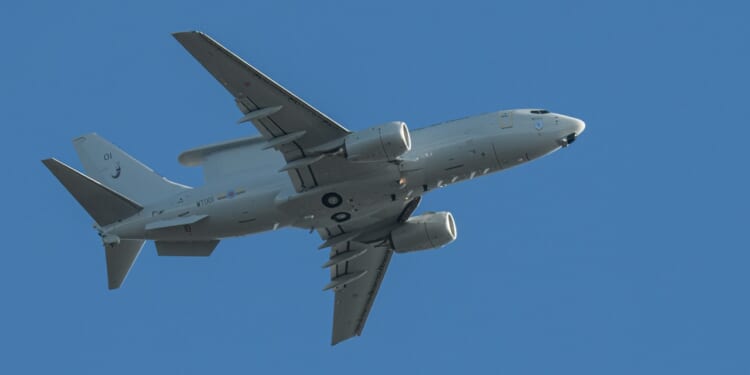The E-7 will serve to link war fighters with commanders, giving enhanced situational awareness to all. But under the current arrangement, that battlefield capability will come at a price.
Earlier this year, the Trump administration reversed a budget proposal to cancel the Air Force’s E-7 Wedgetail airborne early-warning and control (AEW&C) aircraft. The decision secures a long-awaited replacement for the aging E-3 Sentry fleet. But it also sends a major slice of the program’s production overseas—an odd choice for an administration that has long emphasized an America First stance, and more specifically, the idea that Europe should be the primary financier of its own defense. Under the new arrangement, US E-7 prototypes will be modified in Birmingham, England, by a British workforce, before entering the British fleet.
Not Everyone in America Approves of the New E-7 Arrangement
The E-7 decision has garnered mixed reactions. Supporters call it a vital course correction, preserving American air superiority and deepening NATO interoperability. Critics, meanwhile, see something else: yet another example of Washington footing the bill for Europe’s defense and industrial development, a decision that clashes with Trump’s decade-long “America First” refrain.
The decision to center early production in the UK blurs the line between allied cooperation and subsidy. Britain stands to gain about 150 skilled jobs and a share of the NATO supply chain as part of the $337 million British investment in regional growth and training. Much of the bill will ultimately fall to American taxpayers, who will absorb much of the program’s procurement costs. Nevertheless, Trump’s defense team has framed the deal as pragmatic, a way to leverage allied infrastructure to accelerate deliveries. But the simple fact is that the next generation of America’s airborne command fleet will be built, in part, abroad—at a time when the US economy is suffering through a static period, or, “The Great Freeze.”
From a strategic perspective, however, the decision makes more sense. The E-7 offers the US and its allies a modern airborne command platform, at a time when great power competition with Russia and China is escalating. Without the E-7, the US would have been forced to operate without a dedicated theater-scale command platform for the first time in 50 years. In terms of pure capability, the E-7 reversal closes a potentially dangerous capability gap.
Still, the decision cuts against Trump’s perpetual argument that Europe must defend Europe. Now, Trump is underwriting British production to replace an American aircraft. Yes, the program strengthens NATO readiness—but Trump has oft-criticized the alliance itself. So, the E-7 decision supports an alliance Trump has said shouldn’t exist—and further reinforces Europe’s dependency on US defense spending.
About the E-7 Wedgetail
- Year Introduced: 2009 (Royal Australian Air Force service)
- Number Built: ~14 delivered worldwide; >25 planned for the U.S. Air Force and other allies
- Length: 110 ft 4 in (33.6 m)
- Wingspan: 117 ft 5 in (35.8 m)
- Weight (MTOW): 171,000 lb (77,565 kg)
- Engines: Two CFM International CFM56-7B27A turbofans (~27,000 lbf thrust each)
- Top Speed: ~530 mph (460 knots, 850 km/h)
- Range: >3,500 nautical miles (~6,500 km); ~10 hours’ endurance (unrefueled)
- Service Ceiling: 41,000 ft (12,500 m)
- Loadout: No offensive weapons; Northrop Grumman Multi-role Electronically Scanned Array (MESA) radar—top-mounted “top hat” antenna, 360° coverage, multi-target tracking at ranges >200 nautical miles; IFF system, ESM suite, data links (LINK 16 and beyond), secure communications and battle-management consoles
- Crew: 2 (flight) + 10–12 mission operators (typical)
None of this critique is to suggest that the E-7 isn’t a capable aircraft. Indeed, the E-7 represents an engineering breakthrough. The MESA radar, mounted in a distinctive dorsal fin, can scan hundreds of miles in every direction, tracking aircraft, missiles, and ships simultaneously while also managing a live air battle from thousands of feet high.
The E-7 will serve to link war fighters with commanders, giving enhanced situational awareness to all. But under the current arrangement, that battlefield capability will come at a price—with Britain reaping much of the industrial benefits, including jobs, contracts, and supply-chain leverage while American taxpayers fund most of the program.
About the Author: Harrison Kass
Harrison Kass is a senior defense and national security writer at The National Interest. Kass is an attorney and former political candidate who joined the US Air Force as a pilot trainee before being medically discharged. He focuses on military strategy, aerospace, and global security affairs. He holds a JD from the University of Oregon and a master’s in Global Journalism and International Relations from NYU.
Image: Shutterstock / david john abrams.

















